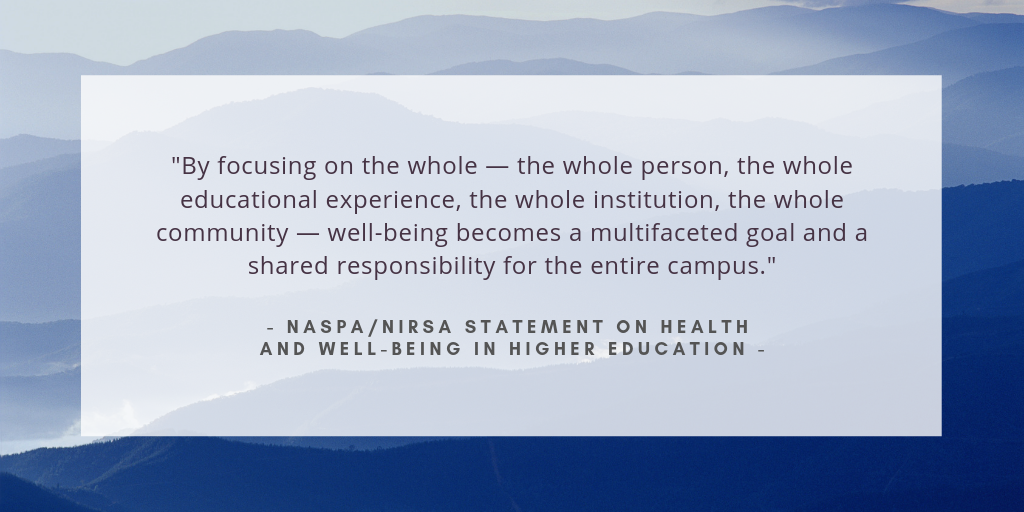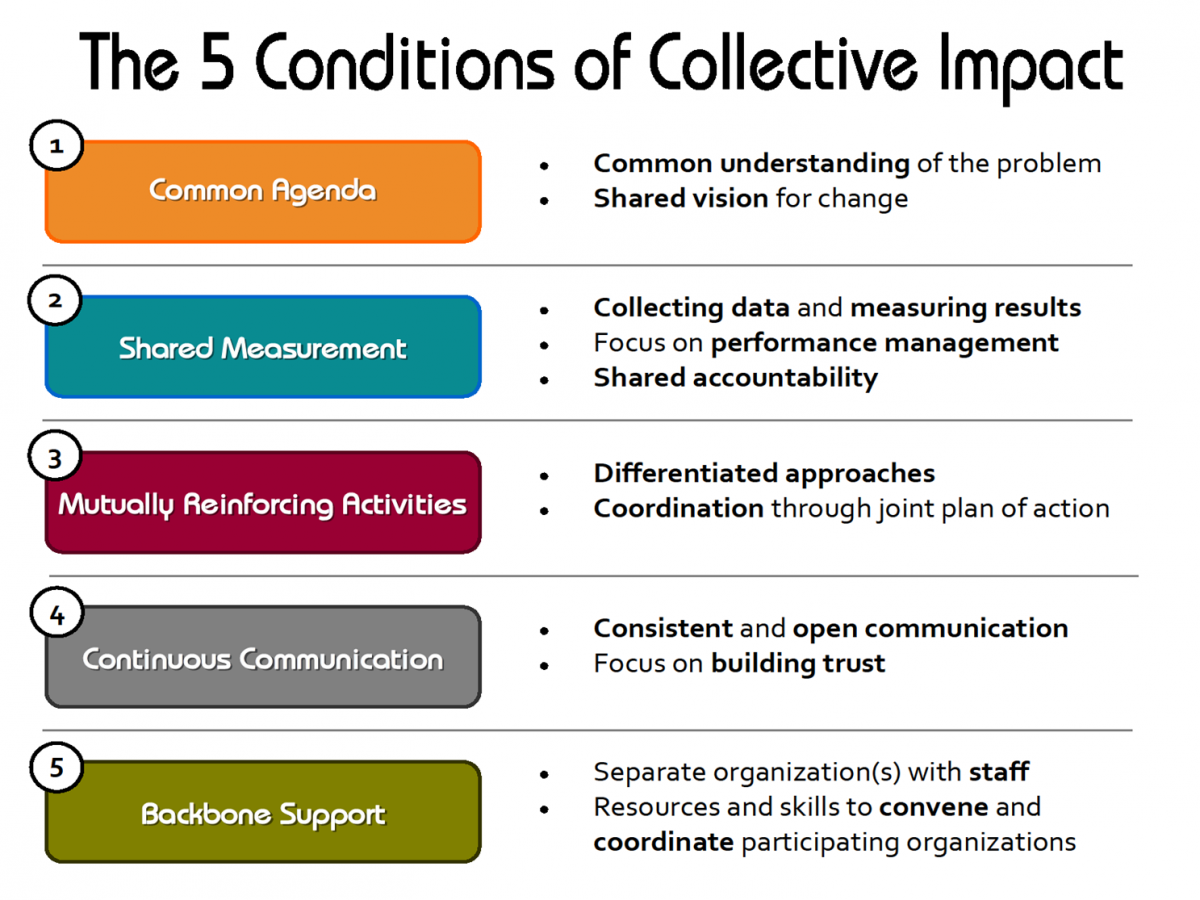There is a popular change happening in higher education.
This movement is the one from “wellness,” often regulated as the work of one or two departments, to “well-being” as an institutional effort.
This shift may seem minor, but it is actually quite significant for anyone working in higher education.
The challenges of wellness work within higher education are no surprise. There are often limits on budget and staff, while expectations remain high and continue to grow amid increased demand. There is also the struggle of trying to create sustainable, impactful programs while these small departments feel siloed.
While the efforts of health promotion and related staff are making a difference despite the obstacles, well-being signifies the evolution of prevention and wellness work into a new realm. It elevates our conversation and now includes everyone.
In order to achieve more, student well-being must be everyone’s vested interest.
“The quality or state of being healthy in body and mind, especially as the result of deliberate effort”
Well-being, however, is defined as:
“A good or satisfactory condition of existence; a state characterized by health, happiness, and prosperity”
Well-being encompasses wellness but is broader, more meaningful, and more contemporary.
Take, for example, this NASPA/NIRSA statement on health and well-being in higher education:

So, what does this move towards well-being look like in higher education and why does it matter? Check out the top reasons why institutions are moving to a well-being model.
3 Reasons Why
1. It’s About “Collective Impact”
In “The Value of Collective Impact for Higher Education Institutions,” Melissa Bender notes that collective impact initiatives have emerged in communities nationwide over the past 10 years.
She defines collective impact as, “a cross-sector collaboration which brings together a broad spectrum of organizations to solve a specific social problem in a community.”
Collective impact aims to provide the systemic and sustainable change that standard collaboration structures aspire to do but often struggle to truly achieve.
Below are the five conditions for the success of collective impact initiatives, which Colin Nelson highlights in “How Collective Impact Can Empower Innovation Challenges in Higher Education”.

Image from the United Way of Nothern California
The value of collective impact in higher education is that it can reinforce the institutional mission. It also focuses and strengthens institutional community engagement efforts and can facilitate community-based research.
Institutions are commonly applying a collective impact approach to one particular social problem: Well-being on college campuses. This shift encourages a broader perspective on well-being and prioritizes it with more collective investment and ownership.
If the goal is to “infuse health and well-being into the campus culture,” as this case study puts it, then collective impact creates a cohesive coordinated effort to make that happen. This approach also indicates a shift in the burden and responsibility of student well-being from select individual departments on a campus to a wider institutional value.
It overcomes many of the challenges that health and wellness professionals have long-encountered in their work — such as trying to achieve lasting change while existing in a silo, engaging stakeholders, reaching intended audiences, and sustaining traction throughout the year.
This new direction for health promotion includes sustainable infrastructures through more innovative, strategic collaboration. This is key because large-scale initiatives often fail by assuming that collaborations can occur without infrastructure.
2. Gallup offers a wealth of resources
In Wellbeing: The Five Essential Elements, Tom Rath and Jim Harter offer a holistic view of what contributes to well-being over a lifetime.
Their book is based on Gallup’s comprehensive study of over 150 countries and a measure of well-being composed of Gallup’s best questions from the last 50 years. In the end, five related factors surfaced that seemed universal to everyone they spoke to in their study: Career well-being, social well-being, financial well-being, physical well-being, and community well-being.
Here is a breakdown of Gallup’s “Five Essential Elements of Well-Being”:
- Career Well-Being: How you occupy your time or simply liking what you do every day
- Social Well-Being: Having strong relationships and love in your life
- Financial Well-Being: Effectively managing your economic life
- Physical Well-Being: Having good health and enough energy to get things done on a daily basis
- Community Well-Being: The sense of engagement you have with the area where you live
Gallup found that while 66% of people are doing well in at least one of these areas, only 7% are thriving in all five.
Next, Gallup shares something that should sound familiar to almost everyone since only 7% are thriving in the areas above: “We allow our short-term decisions to override what’s best for our long-term well-being.”

This age-old battle of decision-making is most true during college. However, Gallup found that people with the highest level of well-being motivated themselves with short-term incentives consistent with their long-term objectives. These short-term incentives make it easier to make the “right decisions” in the moment, such as choosing to exercise the next day because it can boost your mood for the next 12 hours.
This new evidence-based framework provides a possible vehicle for higher education as we better conceptualize the whole person and move from wellness to well-being.
The five essential elements, for example, can serve as a tool to re-envision wellness wheels traditionally used in health promotion. The short-term incentive approach reinforces the validity of what higher education wellness staff have long known is a primary and valuable way to engage students.
In addition, Gallup’s well-being work also offers a Wellbeing Finder, an assessment companion piece to their research that measures well-being over time. Just as universities love StrengthsFinder for its rich usefulness, the move towards well-being in higher education means the Wellbeing Finder may also become a tool to enhance this work.
3. Current initiatives highlight trends to follow
Why else are institutions moving to a well-being model? Because it’s easy to see this is the new chapter. Our colleagues around the country are showing us the way with inspiring programs that are moving in that direction.
If you’re looking to move your institution towards well-being, you don’t have to look far to find the themes emerging with this trend.

First, these programs orient their approach to well-being with a defined framework that serves as a launching pad for deeper initiatives. The wellness wheel, for instance, has been a standard go-to tool in health promotion to guide department efforts.
However, guides like this are now being re-envisioned and used as maps for the collective impact of broader and larger efforts.
UCLA, for example, is home to seven “pods” of well-being: EatWell, MindWell, MoveWell, ResearchWell, BEWell, EngageWell, and BreatheWell. Started in 2012, its Healthy Campus Initiative strives to “make the healthy choice an easy choice”. Each pod is home to its own programming and initiatives, open committee meetings, and website. The EatWell pod, for example, has a seven-point programming model that includes food security, food literacy, and campus food gardens.
George Mason University aspires to be a “well-being university” but instead of a wellness wheel or pods, its program is built around the institution’s definition of well-being, which includes vitality, purpose, resilience, and engagement.
Another theme in well-being models is the application of a collective impact approach. UCLA reflects a collective impact approach because it is campus-wide with a common agenda, draws upon research and teaching, seeks to promote health on campus, and shares information with local communities.
The “shared measurement” condition of collective impact is demonstrated by The Wellness Network at The University of Texas at Austin, where there is an emphasis on data from the American College Health Association, shared in various forms like topical “Issue Briefs”.
George Mason University exemplifies the fifth condition of collective impact by having a “backbone support” organization to lead efforts: The Center for the Advancement of Well-Being, which lives in the College of Humanities and Social Sciences. On its own, this center supports a well-being living-learning community, a well-being academic minor and courses, and the GMU Resilience Model.
Beyond this, however, this center is home to GMU’s well-being initiative called Mason: Thriving Together. The initiative includes its own learning outcomes and online well-being assessments, as well as access to Gallup’s StrengthsFinder assessment. It is made up of over 45 members of the university community from 16 campus offices and centers.
If your institution is exploring a move to well-being, you might also consider establishing open committees. As mentioned earlier, UCLA has seven pods of well-being with seven corresponding open committees.
The Wellness Network from the University of Texas at Austin also features seven committees open to the campus community, including hazing prevention, bystander intervention, and mental health promotion. Having stakeholders involved in this way can garner the kind of results a collective impact approach strives to achieve.
Similarly, your institution should aim for strategic and steady relationships among a range of campus partners — not just for an event here or there but throughout the year.

Residential life, university police, the college of health and human services, and the associated student association are among those partners in the Live Well Aztecs program from San Diego State University. Plus, the WE Wellness Environment from The University of Vermont demonstrates a great blend of academic and student affairs work among the college of medicine, residential life, and others.
A final theme of the move to well-being is the inclusion of innovative offerings.
For example, technology opens the door to more well-being resources and support at the University of Memphis with the YOU@Memphis program. For institutions looking to enhance efforts with platforms that appeal to Generation Z’s affinity for digital resources, YOU at College “personalizes well-being for every student” by bringing together “campus resources, original content, tools, and assessments created and vetted by behavioral health experts.”
The approach is holistic with three sections for well-being: Succeed (academic success and career preparedness), Thrive (physical and mental health) and Matter (a student’s purpose and connection to campus).
What else is on trend for a well-being model? Well-being coaching. The Office of Well-Being at Wake Forest University offers appointments with master’s level well-being coaches to faculty, staff, and students. Within Wake Forest’s well-being initiative, called Thrive, each of their eight dimensions of well-being features its own blog content.
Is your campus making the move towards a well-being model? What are you learning along the way? We would love to hear from you! Drop us a note at @PriyaThomas757 or @HelloPresence.





